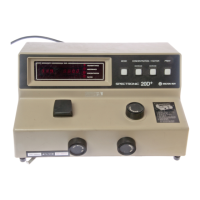Appendix.A -Choosing a Readout Mode
Transmittance Mode
All SPECTRONICISI 20+ series spectrophotometers
measure the relative amount of light transmitted,
yielding results in transmittance. The transmittance
mode is useful for calibration, stray radiant energy
tests and filter studies. Furthermore, very low
concentrations may be measured with greater
sensitivity in the transmittance mode. When the
transmittance mode is used, the reagent blank sets
lOO%T, and the results for standard solutions and
unknown samples are obtained as percent
transmittance.
To eliminate %T to A calculations, each model of the
insb"ument provides conversion of transmittance to
absorbance:
.The SPECTRONIC~ 20+ has an absorbance scale
marked with values corresponding to percent
transmittance. The operator may simply read the
absorbance scale and use these values to consb"uct a
standard curve as described above.
.The SPECTRONIC~ 200+ offers precise electronic
conversion of transmittance to absorbance. When
the absorbance mode is used, the reference blank
sets O.OOOA, and the results for standards and
unknowns are obtained in absorbance. Results in
absorbance may be related to concentration by
Beer's Law, A=abc, if the absorptivity and
pathlength are known, or by consb"uctions of a
standard curve as described above.
A standard curve may be constructed on
semi-logarithmic paper by plotting the percent
transmittance on the logarithmic axis vs. the
concentration of known standard solutions on the
linear axis. The best line is drawn through these
points. The concentration of unknown samples may
then be determined by locating the concentration
value which corresponds to the percent transmittance
of the unknown on the standard curves.
Absorbance measurements are useful for kinetics
studies and for reaction systems which do not obey
Beer's Law and therefore have non-linear standard
plots.
Concentration Mode
Absorbance Mode
The SPECTRONICIII 20D+ provides a more
convenient readout, the concentration mode, which
eliminates the necessity for constructing a standardcurve.
The instrument electronically converts results
in absorbance to concentration units by multiplying
the absorbance value by the factor which is the inverse
of the slope of the standard curve (factor = l/ab).
Usually, the operator desires results in absorbance for
direct correlation of concentration by Beer's Law:
A=abc. Results in percent transmittance may be
converted to absorbance values by use of
transmittance-absorbance conversion tables or by the
formula A=-log,o T. Results in absorbance may be
plotted against the concentration of known standards
on rectilinear graph paper. The best line is drawn
through these points to construct a standard curve.
The concentration of unknowns may then be
detennined by locating on the standard curve the
concentration value which corresponds to the
absorbance of the unknown.
Note that the concentration mode can be used only if
the linearity of the standard curve has been verified
for the test conditions used. These test conditions
include wavelength, concentration range of interest,
cuvette pathlength and analytical procedure.
Furthermore, the concentration mode may be used
only if the standard curve has a positive slope (i.e.,
absorbance increases with concentration).

